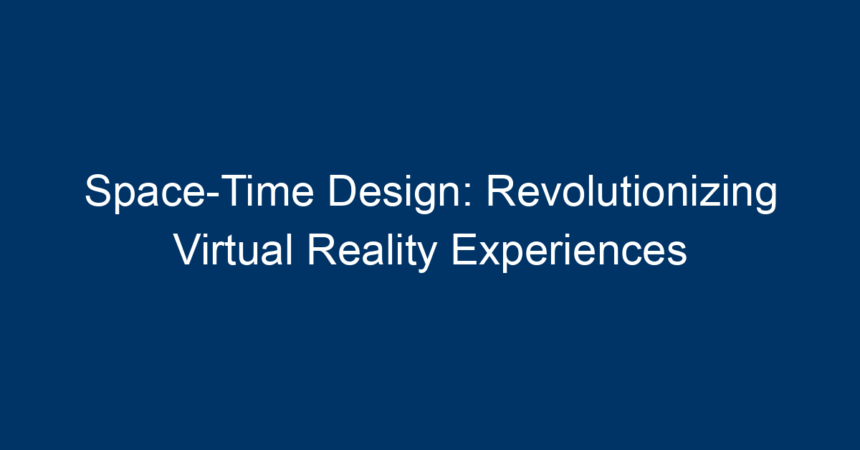The emergence of virtual reality (VR) has transformed how we interact with digital environments, blurring the lines between the virtual and the real. At the forefront of this transformation is the innovative concept of space-time design. This approach not only redefines our understanding of spatial dimensions in virtual environments but also integrates temporal aspects to create immersive user experiences. In this article, we will explore the fundamentals of space-time design, its applications in virtual reality, and how it stands to reshape our interactions with technology.
What is Space-Time Design?
Space-time design is a multidisciplinary approach that combines elements of architecture, engineering, and digital technology to create immersive environments. It focuses on two critical dimensions: space, referring to the physical or virtual layout, and time, which encompasses the evolution of an experience over time.
By considering both dimensions, space-time design enhances user experiences in VR by ensuring they are engaging, interactive, and responsive to user actions. This design philosophy acknowledges that our interactions are not merely confined to spatial navigation but also encompass temporal dynamics, creating a more authentic and immersive experience.
The Evolution of Virtual Reality and Space-Time Design
Understanding how space-time design fits into the broader landscape of VR requires historical context. Early VR systems were largely based on simplistic graphical representations and limited interactivity. As technology advanced, developers began to appreciate the importance of creating more realistic and engaging environments. This led to the integration of space-time principles in VR design.
-
Realism in Virtual Environments: The introduction of realistic physics engines and high-resolution graphics allowed developers to create lifelike environments. Space-time design enhances this realism by adding layers of depth and interaction based on the user’s movements and decisions.
- Interactivity Beyond Space: Earlier VR experiences focused heavily on spatial interactions—moving from one point to another within a virtual environment. However, space-time design introduces a temporal element, allowing experiences to evolve dynamically based on user interactions and choices.
Key Principles of Space-Time Design
To fully leverage the benefits of space-time design in virtual reality, several key principles should be considered:
-
User-Centric Design: The design process should prioritize the user’s experience. Engaging users through intuitive interactions and responsive environments enhances immersion and satisfaction.
-
Dynamic Environments: VR environments should evolve over time, responding to user actions and decisions. For instance, in an educational VR simulation, the scenario may change based on a user’s choices, creating a more personalized learning experience.
-
Spatial Awareness: Users must have a clear understanding of their surroundings within a virtual space. Space-time design employs techniques such as guided pathways and visual cues to enhance spatial awareness.
- Narrative Integration: Storytelling is an essential facet of space-time design. By integrating narratives that unfold over time, developers can create a more engaging and coherent experience that captivates users.
Applications of Space-Time Design in Virtual Reality
The potential of space-time design extends across various industries, each benefiting from this innovative approach.
1. Gaming
The gaming industry has been one of the first to embrace space-time design principles. Games can create engaging narratives that evolve based on players’ choices, making each playthrough unique. Dynamic environments respond to players’ actions, providing a rich tapestry of interactions that can adjust in real-time. For example, a character’s actions might lead to different outcomes in the game world, creating a sense of consequence and involvement.
2. Education and Training
Educational VR applications can utilize space-time design to offer immersive simulations that change based on a learner’s input. For example, medical students can practice in virtual simulations where patient scenarios evolve based on their decisions and actions. By integrating immediate feedback and dynamic situations, these experiences enhance critical thinking and problem-solving skills.
3. Architectural Visualization
Architects and designers are using space-time design to create virtual walkthroughs of architectural projects. Clients can explore buildings that evolve through different stages of construction or design. As they navigate through a project, they can see design elements change in real-time, gaining insights that traditional 2D plans cannot provide.
4. Mental Health and Therapy
Virtual reality is increasingly being used in therapeutic settings. Space-time design can create safe environments for patients to confront fears or practice coping mechanisms. For instance, exposure therapy for phobias can dynamically adjust the scenarios based on patient reactions, leading to more effective treatment outcomes.
Overcoming Challenges in Space-Time Design
While the benefits of space-time design in virtual reality are clear, several challenges must be addressed to maximize its potential.
-
Technical Limitations: Realistically implementing dynamic environments requires significant computational power and sophisticated software development. As technology continues to advance, overcoming these technical barriers will be crucial.
-
User Experience Design: Balancing immersion with usability is a constant challenge. Developers must ensure that while environments are engaging and dynamic, they remain intuitive and user-friendly.
- Content Creation: Creating rich, responsive content that takes advantage of space-time design principles can be resource-intensive. Collaboration across disciplines—such as artists, engineers, and developers—is essential for successful implementation.
The Future of Space-Time Design in Virtual Reality
As we look to the future, the integration of space-time design in virtual reality is poised for significant growth. Emerging technologies such as artificial intelligence and machine learning will allow for even more personalized and adaptive experiences, further enhancing the principles of space-time design.
-
AI-Driven Environments: AI can analyze user behaviors and adapt environments in real-time, creating experiences tailored to individual preferences and actions. This could revolutionize gaming, education, and therapeutic applications.
-
Cross-Reality Experiences: The blend of physical and virtual realities, known as mixed reality, can further amplify the effects of space-time design. Users will navigate environments that seamlessly transition from real to virtual, enriching their interactions.
- Increased Accessibility: As VR technology becomes more accessible, space-time design principles will facilitate experiences tailored for diverse audiences, ensuring inclusivity and engagement.
Conclusion: Embracing Space-Time Design for the Future
The concept of space-time design is revolutionizing virtual reality experiences by integrating spatial and temporal dimensions into immersive environments. By focusing on user-centric design, dynamic environments, and integrated narratives, this approach enhances engagement and effectively transforms how we interact with digital worlds.
As we move forward, understanding and implementing space-time design principles will be pivotal for developers and organizations looking to create innovative and compelling VR experiences. Embracing these practices not only enhances the quality of virtual experiences but also positions businesses at the forefront of a rapidly evolving technological landscape.
To harness the full potential of space-time design, consider investing in training and collaboration with industry experts, prototyping innovative concepts, and iterating based on user feedback. The future of virtual reality is bright, and space-time design is a key element that will drive its evolution.
By staying ahead of these trends, individuals and organizations can ensure they remain relevant in an increasingly immersive digital world.




